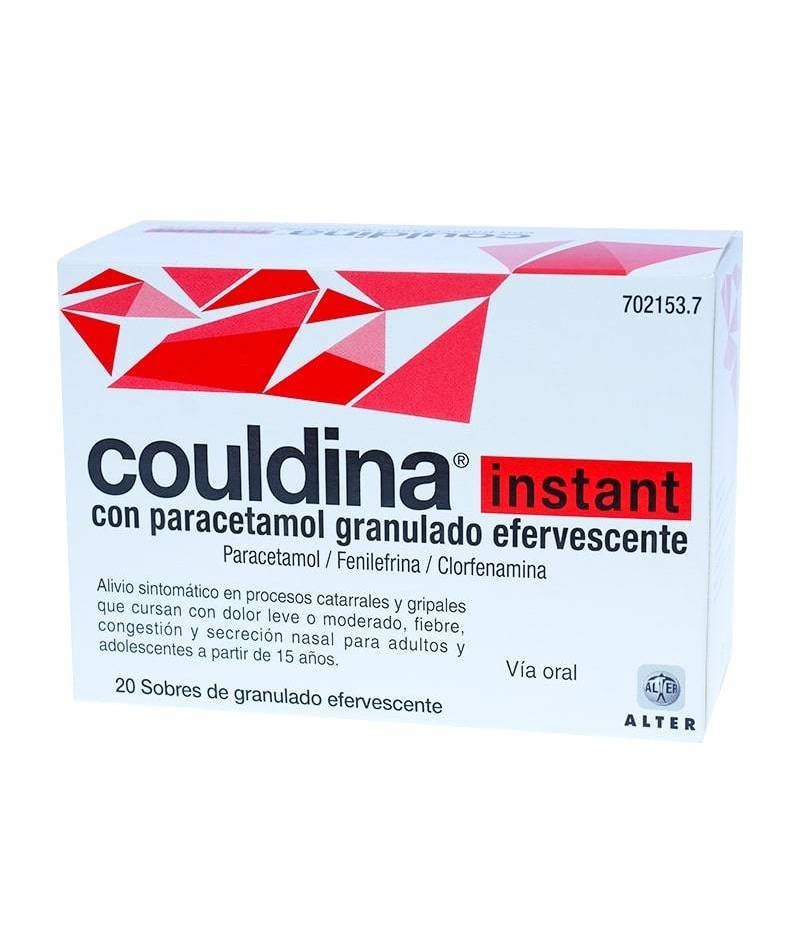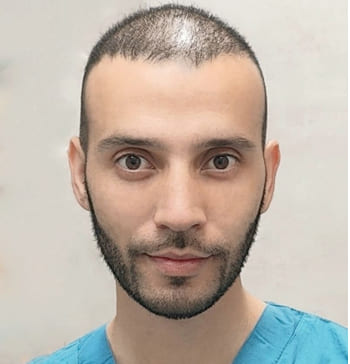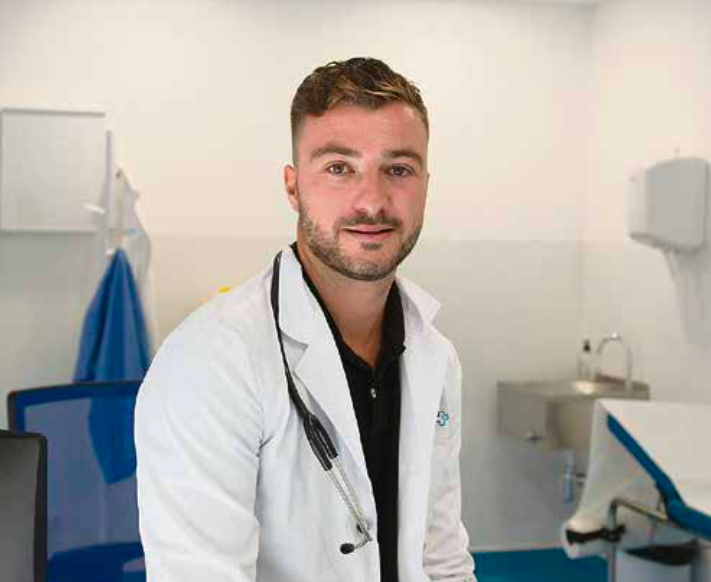

КУЛДІНА ІНСТАНТ З ПАРАЦЕТАМОЛОМ ГРАНУЛИ ДЛЯ ПРИГОТУВАННЯ РОЗЧИНУ (ШИПУЧІ)

Запитайте лікаря про рецепт на КУЛДІНА ІНСТАНТ З ПАРАЦЕТАМОЛОМ ГРАНУЛИ ДЛЯ ПРИГОТУВАННЯ РОЗЧИНУ (ШИПУЧІ)

Інструкція із застосування КУЛДІНА ІНСТАНТ З ПАРАЦЕТАМОЛОМ ГРАНУЛИ ДЛЯ ПРИГОТУВАННЯ РОЗЧИНУ (ШИПУЧІ)
Вступ
Проспект: інформація для користувача
Кудіна інстант з парацетамолом гранульований ефervescente
Парацетамол / Фенілефрина / Хлорфенамін
Прочитайте уважно весь проспект перед тим, як почати приймати цей лікарський засіб, оскільки він містить важливу інформацію для вас.
Слідуйте точно інструкціям щодо застосування лікарського засобу, наведеним у цьому проспекті або вказаним вашим лікарем чи фармацевтом.
- Збережіть цей проспект, оскільки вам може знадобитися знову його прочитати.
- Якщо вам потрібна порада або додаткова інформація, проконсультуйтеся з фармацевтом.
- Якщо ви відчуваєте побічні ефекти, проконсультуйтеся з лікарем або фармацевтом, навіть якщо це побічні ефекти, які не наведені в цьому проспекті.
- Вам слід проконсультуватися з лікарем, якщо ваш стан погіршується або не покращується, або якщо лихоманка триває більше 3 днів або біль чи інші симптоми тривають більше 5 днів.
Зміст проспекту
- Що таке Кудіна інстант з парацетамолом і для чого він використовується
- Що вам потрібно знати перед тим, як почати приймати Кудіна інстант з парацетамолом
- Як приймати Кудіна з парацетамолом
- Можливі побічні ефекти
- Зберігання Кудіни з парацетамолом
- Зміст упаковки та додаткова інформація
1. Що таке Кудіна інстант з парацетамолом і для чого він використовується
Це асоціація парацетамолу, хлорфенаміну та фенілефрини.
Парацетамол - це анальгетик, який зменшує боль і лихоманку.
Хлорфенамін - це антигістамін, який полегшує виділення слизу з носа.
Фенілефрина - це симпатикомітетик, який зменшує закладення носа.
Він показаний для дорослих і підлітків від 15 років для полегшення симптомів простуди та грипу, які супроводжуються лихоманкою або болем легкого чи середнього ступеня, закладенням носа та виділенням слизу.
Вам слід проконсультуватися з лікарем, якщо ваш стан погіршується або не покращується, або якщо лихоманка триває більше 3 днів або біль чи інші симптоми тривають більше 5 днів.
2. Що вам потрібно знати перед тим, як почати приймати Кудіна інстант з парацетамолом
Не приймайте Кудіна інстант з парацетамолом
- Якщо ви алергічні на активні речовини або на будь-які інші компоненти цього лікарського засобу (наведені в розділі 6).
- Якщо ви страждаєте на гіпертонію.
- Якщо ви страждаєте на гіпертиреоз.
- Якщо ви страждаєте на цукровий діабет.
- Якщо ви страждаєте на тахікардію (швидке серцебиття).
- Якщо ви перебуваєте на лікуванні деякими лікарськими засобами, такими як інгібітори моноамінооксидази (ІМАО) (наприклад, деякі антидепресанти або лікарські засоби для лікування хвороби Паркінсона).
- Якщо ви перебуваєте на лікуванні симпатикомітетиками (лікарськими засобами, які використовуються для лікування астми або для прискорення серцебиття).
- Якщо ви перебуваєте на лікуванні бета-блокаторами (лікарськими засобами для серця або для лікування захворювань артерій) (див. розділ "Прийом Кудіни інстант з парацетамолом з іншими лікарськими засобами").
- Якщо ви страждаєте на глаукому (підвищення внутрішньоочного тиску).
- Якщо ви страждаєте на важкі захворювання серця чи артерій (наприклад, коронарну хворобу чи стенокардію).
- Якщо ви страждаєте на важкі захворювання печінки чи нирок.
Дітям до 15 років не можна приймати цей лікарський засіб.
Попередження та обережність
Проконсультуйтеся з лікарем або фармацевтом перед тим, як почати приймати цей лікарський засіб.
- Не приймайте більше лікарського засобу, ніж рекомендовано в розділі 3: "Як приймати Кудіна з парацетамолом".
- Ви повинні уникати одночасного прийому цього лікарського засобу з іншими лікарськими засобами, які містять парацетамол, оскільки високі дози можуть призвести до ушкодження печінки. Не використовуйте більше одного лікарського засобу, який містить парацетамол, без консультації з лікарем.
- Хронічні алкоголіки повинні бути обережними і не приймати більше 3 пакетиків протягом 24 годин.
- Вам слід проконсультуватися з лікарем перед тим, як прийняти цей лікарський засіб:
- Пацієнти з захворюваннями нирок, печінки, серця чи легень і пацієнти з анемією.
- Пацієнти з бронхіальною астмою, чутливі до ацетилсаліцилової кислоти.
- Пацієнти, чутливі (алергічні) до антигістамінних лікарських засобів, оскільки вони можуть бути чутливими до інших антигістамінних лікарських засобів (наприклад, хлорфенаміну).
- Пацієнти, які перебувають на лікуванні лікарськими засобами для лікування гіпертрофії передміхурової залози, бронхіальної астми, повільного серцебиття, гіпотонії, цереброваскулярних захворювань, панкреатиту, виразкової хвороби (пептичної виразки), обструкції пілородуоденальної області (між шлунком і кишкою), захворювань щитоподібної залози, пацієнти, чутливі до седативної дії деяких лікарських засобів.
- Якщо ви перебуваєте на лікуванні трициклічними антидепресантами або лікарськими засобами з подібною дією і у вас з'являються проблеми з шлунково-кишковим трактом, ви повинні припинити приймати цей лікарський засіб і негайно проконсультуватися з лікарем, оскільки у вас може розвинутися паралітичний ілеус (зупинка руху частини кишківника).
- Якщо у вас є важкі захворювання, такі як важка ниркова недостатність або сепсис (коли бактерії та їхні токсини циркулюють у крові, що призводить до ушкодження органів), або якщо ви страждаєте на малнутріцію, хронічний алкоголізм або якщо ви також приймаєте флуклоксацилін (антибіотик). Було повідомлено про важке захворювання, яке називається метаболічною ацидозою (анормальністю крові та рідини) у пацієнтів у цих ситуаціях, коли парацетамол використовується у звичайних дозах протягом тривалого періоду або коли парацетамол приймається разом з флуклоксациліном. Симптоми метаболічної ацидози можуть включати: важку дихальну недостатність з глибоким і швидким диханням, сонливість, відчуття нездужання (нудота) і блювоту.
- У разі дефіциту глюкози-6-фосфатдегідрогенази (Г6ФД) (може призвести до гемолітичної анемії).
Діти та підлітки
Дітям до 15 років не можна приймати цей лікарський засіб.
Перешкоди для аналітичних тестів:
Якщо вам мають зробити якийсь аналітичний тест (включно з аналізами крові, сечі тощо), повідомте своєму лікареві, що ви приймаєте цей лікарський засіб, оскільки він може змінити результати.
Прийом Кудіни інстант з парацетамолом з іншими лікарськими засобами
Повідомте своєму лікареві або фармацевту, якщо ви приймаєте або нещодавно приймали інші лікарські засоби.
Особливо, якщо ви використовуєте деякі з наступних лікарських засобів, оскільки може бути необхідне змінити дозу деяких з них або припинити лікування:
- Лікарські засоби для лікування епілепсії: антиепілептичні препарати (ламотриджин, фенітойн або інші гідантоїни, фенобарбітал, метилфенобарбітал, примідон, карбамазепін).
- Лікарські засоби для лікування туберкульозу: (ізоніазид, рифампіцин).
- Лікарські засоби для лікування конвульсій і депресії (барбітурати), які використовуються як гіпнотики, седативні та антиконвульсивні засоби.
- Лікарські засоби для профілактики утворення кров'яних згустків: пероральні антикоагулянти (аценокумарол, варфарин).
- Лікарські засоби, які використовуються для збільшення виділення сечі (діуретики петлі, такі як фуросемід, або інші діуретики), та інші діуретики, які призводять до втрати калію (наприклад, діуретики для лікування гіпертонії чи інших захворювань).
- Лікарські засоби, які використовуються для профілактики нудоти та блювоти: метоклопрамід і домперидон.
- Лікарські засоби, які використовуються для лікування подагри (пробенецид і сульфінпіразон).
- Лікарські засоби, які використовуються для лікування гіпертонії та порушень серцевого ритму (аритмій): пропранолол.
- Лікарські засоби, які використовуються для зниження рівня холестерину в крові: (холестирамін).
- Лікарські засоби, які використовуються для лікування депресії, хвороби Паркінсона чи інших захворювань (інгібітори моноамінооксидази (ІМАО)). Відповідно до рекомендацій, прийом Кудіни інстант з парацетамолом повинен бути припинений не менше ніж за 15 днів до закінчення лікування.
- Лікарські засоби, які використовуються для лікування мігрені; лікарські засоби, які приймаються під час пологів; лікарські засоби, які приймаються для лікування гіпертонії чи інших захворювань (альфа-адреноблокатори).
- Альфа- і бета-адреноблокатори, такі як лабеталол і карведилол (використовуються для серця чи для лікування захворювань артерій).
- Лікарські засоби, які використовуються для лікування депресії (трициклічні антидепресанти).
- Загальні анестетики.
- Антигіпертензивні лікарські засоби (лікарські засоби для зниження артеріального тиску).
- Лікарські засоби, які використовуються для серця, такі як серцеві глікозиди, антиаритмічні засоби та бета-адреноблокатори.
- Лікарські засоби, які містять тиреоїдні гормони (використовуються для лікування захворювань щитоподібної залози).
- Лікарські засоби, які використовуються для лікування захворювань серця чи захворювань травної системи (атропін сульфат).
- Лікарські засоби, які призводять до депресії центральної нервової системи (наприклад, лікарські засоби, які використовуються для лікування безсоння чи тривоги).
- Лікарські засоби, які мають ототоксичну дію (призводять до ушкодження вуха).
- Лікарські засоби, які мають фотосенсибілізуючу дію (призводять до алергічної реакції на світло).
- Флуклоксацилін (антибіотик), через ризик важкої порушення ацидозної рівноваги крові та рідини (метаболічна ацидоза), яке потребує термінового лікування (див. розділ 2).
Прийом Кудіни інстант з парацетамолом з харчовими продуктами, напоями та алкоголем
Під час лікування цим лікарським засобом не слід вживати алкогольні напої, оскільки це може посилити появу побічних ефектів лікарського засобу.
Крім того, використання лікарських засобів, які містять парацетамол, пацієнтами, які регулярно вживають алкоголь (3 або більше алкогольних напоїв: пиво, вино, лікер тощо на добу), може призвести до ушкодження печінки.
Прийом цього лікарського засобу з харчовими продуктами не впливає на його ефективність.
Вагітність та лактація
Якщо ви вагітні або перебуваєте в період лактації, вважаєте, що можете бути вагітною або плануєте вагітність, проконсультуйтеся з лікарем або фармацевтом перед тим, як використовувати цей лікарський засіб.
Цей лікарський засіб не повинен прийматися під час вагітності, якщо тільки лікар не вважає це абсолютно необхідним.
Цей лікарський засіб не можна використовувати під час лактації, оскільки він може призвести до побічних ефектів у дитини.
Водіння транспортних засобів та робота з механізмами
Цей лікарський засіб може призвести до сонливості, порушуючи психічну та фізичну здатність. Якщо ви відчуваєте ці ефекти, уникайте водіння транспортних засобів або роботи з механізмами.
Кудіна інстант з парацетамолом містить натрій
Цей лікарський засіб містить 460,9 мг натрію (основної складової кухонної солі) в кожному пакетику. Це відповідає 24% від максимальної добової норми споживання натрію, рекомендованої для дорослих.
Проконсультуйтеся з лікарем або фармацевтом, якщо вам потрібно приймати 1 або більше пакетиків на добу протягом тривалого періоду, особливо якщо вам рекомендовано дієта з низьким вмістом солі (натрію).
3. Як приймати Кудіна з парацетамолом
Слідуйте точно інструкціям щодо застосування лікарського засобу, наведеним у цьому проспекті або вказаним вашим лікарем чи фармацевтом.
Рекомендована доза:
Дорослі та підлітки від 15 років:
1 пакетик (650 мг парацетамолу) кожні 6-8 годин за необхідності (3 або 4 пакетики на добу).
Не приймайте більше 3 грамів парацетамолу на добу (див. розділ "Попередження та обережність").
Пацієнти з нирковою недостатністю:
Цей лікарський засіб не можна приймати через дозу парацетамолу.
Пацієнти з печінковою недостатністю:
Проконсультуйтеся з лікарем
У разі печінкової недостатності чи синдрому Гілберта не слід перевищувати 3 пакетики на добу, а мінімальний інтервал між прийомами повинен становити 8 годин.
Використання у дітей
Цей лікарський засіб протипоказаний дітям та підліткам до 15 років.
Використання у пацієнтів похилого віку
Люди похилого віку не можуть використовувати цей лікарський засіб без консультації з лікарем.
Бо вони можуть бути особливо чутливими до деяких побічних ефектів лікарського засобу, таких як появу повільного серцебиття (брадикардії) або зниження серцевого викиду, через вміст фенілефрини та хлорфенаміну. Крім того, вони можуть бути більш схильними до побічних ефектів, таких як седація, сплутаність, гіпотонія чи збудження, та можуть бути більш чутливими до ефектів, таких як сухість у роті та затримка сечі.
Як приймати
Кудіна інстант з парацетамолом приймається перорально. Розчиніть пакетик повністю у невеликій кількості рідини, бажано в половині склянки води, а потім випийте.
Всегда приймайте мінімальну ефективну дозу.
Прийом цього лікарського засобу залежить від появи симптомів. По мірі їх зникнення лікування повинно бути припинено.
Якщо лихоманка триває більше 3 днів лікування, біль чи інші симптоми тривають більше 5 днів, або якщо ваш стан погіршується або з'являються нові симптоми, вам слід проконсультуватися з лікарем.
Якщо ви прийняли більше Кудіни інстант з парацетамолом, ніж потрібно
Якщо ви прийняли过剂ку, негайно зверніться до медичного центру, навіть якщо ви не відчуваєте симптомів, оскільки вони часто не проявляються до 3 днів після прийому过剂ки, навіть у випадках важкої інтоксикації.
Симптоми过剂ки можуть включати: головокружіння, блювоту, втрату апетиту, жовтяницю шкіри та очей (жовтяницю) та біль у животі. Тревога, страх, збудження, головний біль (може бути симптомом високого тиску), конвульсії, безсоння (або сильна сонливість), незграбність, відчуття передсмертної слабкості, нестабільність, сплутаність, раздражливість, тремор, анорексія; психоз з галюцинаціями (останнє особливо у дітей). Сухість у роті, носі чи горлі. Ефекти, такі як підвищений тиск, аритмія (швидке або нерегулярне серцебиття), палпітації, зниження виділення сечі. Ацидоз (зниження лужної резерву крові). При тривалому застосуванні може розвинутися дефіцит об'єму плазми (зниження об'єму крові).
Лікування过剂ки є більш ефективним, якщо його розпочато протягом 4 годин після прийому过рядку лікарського засобу.
Пацієнти, які приймають барбітурати або хронічні алкоголіки, можуть бути більш чутливими до токсичної дії过рядку парацетамолу. Перерозподіл також може призвести до порушення згортання крові (тромбозу та кровотечі).
У разі过рядку або випадкового прийому негайно зверніться до медичного центру або зателефонуйте до служби токсикологічної інформації (телефон 91 562 04 20), вказавши лікарський засіб та кількість, прийняту.
4. Можливі побічні ефекти
Як і всі ліки, Couldina instant з парацетамолом може викликати побічні ефекти, хоча не всі люди їх відчувають.
Під час періоду використання асоціації парацетамолу, фенілефрину та хлорфеніраміну повідомлялися наступні побічні ефекти, чию частоту не встановлено точно:
- Побічні ефекти, які можуть виникати найчастіше, це:
Легка сонливість, головокружіння, м'язова слабкість: ці побічні ефекти можуть зникнути після 2-3 днів лікування. Труднощі у рухах обличчя, неуклюзість, тремор, порушення відчуттів та оніміння, сухість у роті, втрата апетиту, порушення смаку чи нюху, шлунково-кишкові розлади (які можуть зменшитися, якщо лікарський засіб приймається разом з їжею), нудота, блювота, діарея, запор, біль у шлунку, затримка сечі, сухість у носі та горлі, загустіння слизу, потіння, розмитість зору чи інші порушення зору.
- Побічні ефекти, які можуть виникати рідко, це:
Розлад, зниження артеріального тиску (гіпотонія), та підвищення рівня трансаміназ у крові. Інфаркт міокарда, порушення ритму серця (аритмія), набряк легень (збільшення об'єму рідини в легенях) та крововилив у мозок (при високих дозах або у чутливих пацієнтів).
Нервове збудження (зазвичай при високих дозах, та частіше у старих людей та дітей), яке може включати симптоми, такі як: безсоння, нервозність та навіть судоми. Інші побічні ефекти, які можуть виникати рідко, це: тиск у грудній клітці, шуми у легенях, швидке чи нерегулярне серцебиття (зазвичай при передозуванні), порушення функції печінки (які можуть проявлятися болем у шлунку чи животі, темною сечею чи іншими симптомами), алергічна реакція, реакції гіперчутливості (кашель, труднощі з ковтанням, швидке серцебиття, свербіж, набряк повік чи навколо очей, обличчя, язика, труднощі з диханням тощо), фоточутливість (чутливість до сонячного світла), чутливість до лікарських засобів, пов'язаних з хлорфеніраміном. Порушення крові (зміни у формулі кров'яних клітин, таких як агранулоцитоз, лейкопенія, апластична анемія, тромбоцитопенія) з симптомами, такими як незвичайне кровотеча, біль у горлі чи втома; зниження чи підвищення артеріального тиску, набряк, порушення слуху, імпотенція, порушення менструального циклу.
- Побічні ефекти, які можуть виникати дуже рідко, це:
Хвороби нирок, каламутна сеча, алергічний дерматит (шкірний висип), жовтяниця (жовтізація шкіри), порушення крові (нейтропенія, гемолітична анемія) та гіпоглікемія (зниження рівня цукру у крові).
Парацетамол може пошкодити печінку при прийомі у високих дозах або при тривалому лікуванні.
Відомі дуже рідкі випадки серйозних реакцій на шкірі.
- Побічні ефекти, чию частоту виникнення не відомо, це:
Тревога, раздражливість, слабкість, підвищення артеріального тиску (гіпертонія, зазвичай при високих дозах та у чутливих пацієнтів), головний біль (при високих дозах та може бути симптомом гіпертонії), дуже повільне серцебиття (важка брадикардія), зниження калібру кров'яних судин (периферична вазоконстрикція), зниження функції серця, яке особливо впливає на старих людей та пацієнтів з поганою церебральною чи коронарною циркуляцією, можлива генерація чи загострення серцевого захворювання, затримка сечі, блідість, волосся, що стоїть дрижачки, підвищення рівня цукру у крові (гіперглікемія), зниження рівня калію у крові, метаболічний ацидоз (порушення метаболізму), холод у кінцівках (ногах чи руках), червоність, відчуття передзвону (гіпотонія). При високих дозах можуть виникнути: блювота, палпітації, психотичні стани з галюцинаціями; при тривалому лікуванні може виникнути зниження об'єму крові.
Серйозне захворювання, яке може зробити кров більш кислотною (метаболічний ацидоз) у пацієнтів з серйозним захворюванням, які приймають парацетамол (див. розділ 2).
Сповіщення про побічні ефекти
Якщо ви відчуваєте будь-який з побічних ефектів, проконсультуйтеся з вашим лікарем або фармацевтом, навіть якщо це побічні ефекти, які не вказані в цьому листку. Ви також можете повідомити про них безпосередньо через Іспанську систему фармакологічного нагляду за лікарськими засобами для людини: www.notificaram.es. Сповіщення про побічні ефекти може допомогти надати більше інформації про безпеку цього лікарського засобу.
5. Зберігання Couldina instant з парацетамолом
Тримати поза зоною видимості та досягнення дітей.
Не використовувати Couldina instant з парацетамолом після закінчення терміну придатності, вказаного на упаковці, після CAD чи терміну придатності. Термін придатності - останній день місяця, який вказано.
Тримати упаковку ідеально закритою. Зберігати в оригінальній упаковці.
Не зберігати при температурі вище 30°C.
Лікарські засоби не слід викидати у водопровід чи сміття. Відкладайте упаковки та лікарські засоби, які вам не потрібні, у спеціальному пункті SIGRE аптеки. У разі сумніву, запитайте у вашого фармацевта, як позбутися упаковок та лікарських засобів, які вам не потрібні. Таким чином, ви допоможете захистити довкілля.
6. Зміст упаковки та додаткова інформація
Склад Couldina instant з парацетамолом
Кожен пакет містить:
- Як активні речовини: Кожен пакет містить 650 мг парацетамолу, 4 мг малеату хлорфеніраміну та 10 мг гідрохлориду фенілефрину.
- Інші компоненти (експіцієнти) - полівідон К30 (Е-1201), докузат натрію, анігідрид цитринової кислоти (Е-330), гідрогенкарбонат натрію (бікарбонат натрію) (Е-500ii), анігідрид карбонату натрію (Е-500i), содій сакарину (Е-954) та лимонний аромат.
Вигляд продукту та зміст упаковки
Цей лікарський засіб упаковується у монодозові термоселені пакети з комплексної плівки, що складається з паперової шари, шари клею, алюмінієвої плівки та термосоленої плівки кополімеру етилену та акрилової кислоти. Зміст упаковок: 10 та 20 пакетів.
Власник авторизації на комерціалізацію та відповідальна особа за виробництво
Лабораторії Alter, S.A.
Вулиця Матео Інурія, 30
28036, Мадрид
Іспанія
Дата останнього перегляду цього листка: лютий 2025
Детальна та актуальна інформація про цей лікарський засіб доступна на сайті Іспанського агентства лікарських засобів та медичних продуктів (AEMPS) http://www.aemps.es/
- Країна реєстрації
- Діючі речовини
- Потрібен рецептНі
- Виробник
- Інформація є довідковою і не є медичною порадою. Перед прийомом будь-яких препаратів обов'язково проконсультуйтеся з лікарем. Oladoctor не несе відповідальності за медичні рішення, прийняті на основі цього контенту.
- Альтернативи до КУЛДІНА ІНСТАНТ З ПАРАЦЕТАМОЛОМ ГРАНУЛИ ДЛЯ ПРИГОТУВАННЯ РОЗЧИНУ (ШИПУЧІ)Форма випуску: ОРАЛЬНИЙ РОЗЧИН/СУСПЕНЗІЯ, 500 мг; 4 мг; 10 мгДіючі речовини: paracetamol, combinations excl. psycholepticsВиробник: Aristo Pharma Iberia S.L.Не потрібен рецептФорма випуску: ТАБЛЕТКА, 500 мг/200 мгДіючі речовини: paracetamol, combinations excl. psycholepticsВиробник: Laboratorios Cinfa S.A.Не потрібен рецептФорма випуску: ОРАЛЬНИЙ РОЗЧИН/СУСПЕНЗІЯ, 650 мг/2,8 мг/8,21 мгДіючі речовини: paracetamol, combinations excl. psycholepticsВиробник: Opella Healthcare Spain S.L.Не потрібен рецепт
Аналоги КУЛДІНА ІНСТАНТ З ПАРАЦЕТАМОЛОМ ГРАНУЛИ ДЛЯ ПРИГОТУВАННЯ РОЗЧИНУ (ШИПУЧІ) в інших країнах
Найкращі аналоги з тією самою діючою речовиною та терапевтичним ефектом.
Аналог КУЛДІНА ІНСТАНТ З ПАРАЦЕТАМОЛОМ ГРАНУЛИ ДЛЯ ПРИГОТУВАННЯ РОЗЧИНУ (ШИПУЧІ) у Польща
Аналог КУЛДІНА ІНСТАНТ З ПАРАЦЕТАМОЛОМ ГРАНУЛИ ДЛЯ ПРИГОТУВАННЯ РОЗЧИНУ (ШИПУЧІ) у Україна
Лікарі онлайн щодо КУЛДІНА ІНСТАНТ З ПАРАЦЕТАМОЛОМ ГРАНУЛИ ДЛЯ ПРИГОТУВАННЯ РОЗЧИНУ (ШИПУЧІ)
Консультація щодо дозування, побічних ефектів, взаємодій, протипоказань та поновлення рецепта на КУЛДІНА ІНСТАНТ З ПАРАЦЕТАМОЛОМ ГРАНУЛИ ДЛЯ ПРИГОТУВАННЯ РОЗЧИНУ (ШИПУЧІ) – за рішенням лікаря та згідно з місцевими правилами.














